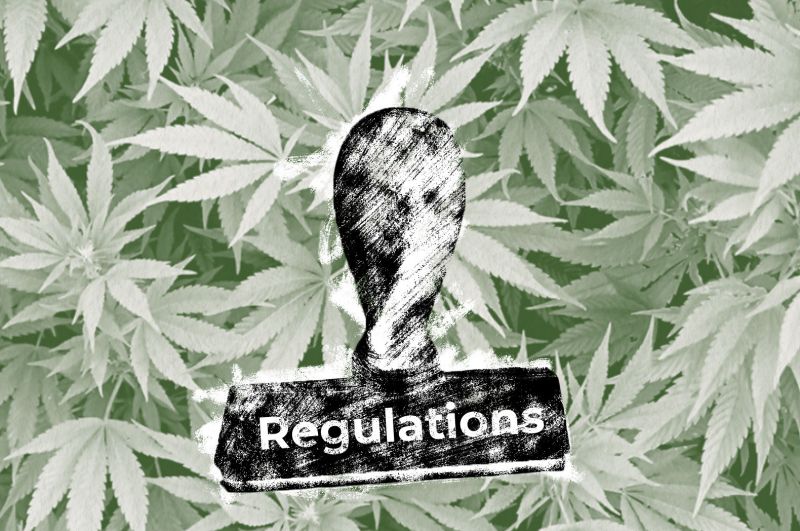
09/11/2021 The Cannabis Reader sits down with Michael Cooper on what's the latest on cannabis beverage regulations.
The Cannabis Reader had a brief chat with Michael Cooper, Managing Member at MadisonJay Solutions about the update in Cannabis Beverage regulations, and here is what he had to say.
1) Tell us about yourself and the work that you do
I found myself in this nascent industry because it was at the intersection of my experiences in the worlds of regulatory law and alcohol.
After Harvard Law, I clerked for a judge on the U.S. Court of Appeals for the Fifth Circuit and practiced at Cravath, Swaine & Moore for a number of years. Then I became the General Counsel of MHW, Ltd., which is one of the leading providers of solutions for independent producers of alcohol. As more states passed adult-use reform, we started getting increasing questions about the space. Ultimately, we launched MadisonJay Solutions in 2017 as a new company to help those at the vanguard of these new industries. I’m both a Co-founder of MadisonJay and its Managing Member.
In addition to my work at MadisonJay, I am active in a number of industry groups to help make sure that cannabis reform continues and results in an effective, efficient marketplace for these products. That includes my service as the co-chair of the National Cannabis Industry Association’s Policy Council, the policy think tank for the nation’s largest non-profit cannabis trade association, and previously chairing its State Regulations Committee.
2) Tell us about MadisonJay
MadisonJay was created in the response to the questions and requests we were receiving at the time. Simply put, adult-use cannabis and hemp-based cannabinoid products are highly regulated. That’s true today, and we anticipate it being true in the future.
So, any effective business strategy in this space needs to take account of the rules that exist today and the rules that are going to exist in the future. Moreover, there’s an additional layer of complexity in these spaces given the variability in rules from jurisdiction to jurisdiction. In other words, entrepreneurs want to build a unified, consistent brand that allows them to compete and thrive under the rules—present and future—in each jurisdiction they’re targeting. MadisonJay helps our clients incorporate a cutting-edge regulatory strategy into their business models.
How do we do that? We take a holistic approach and look at things like potential brand names, logos, narratives, descriptions, marketing, product formulations, and form factors, packaging and labeling, and other imagery not only through the lens of “what is the product and who is the intended audience?” but also “where are you building your brand, both today and for the foreseeable future?”
And in a sign of life coming full circle, after we launched to address these needs in cannabis we started to receive questions about building spirits brands in that highly regulated space. So we now work in the highly regulated spaces of adult-use cannabis, hemp-derived cannabinoid products, and alcoholic spirits.
3) Give us an update on Cannabis Beverage regulations, what’s new, what’s coming
It’s a great question because there are lots of regulatory moving pieces for beverages, and they are going to help make winners (and losers) out of a lot of players.
I’ll flag a handful of areas of recent changes, though it’s far from a complete list in this space. One set of changes over the past year is that the split that continues among markets over the maximum amount of THC permitted per serving. There’s also a split among markets with respect to whether multi-serving beverages (as opposed to single-serving) are even permitted for sale. Another interesting regulatory consideration that we’ve longed flagged: increased scrutiny over expiration dates. There are also ongoing evolutions to packaging rules that brands need to stay on top of. For example, California has had a couple of tweaks in recent months to the packaging options for beverages.
But just as strategically important as these beverage-specific changes, more markets continue to move towards permitting social consumption venues. It’s not a beverage-specific set of rules, but given the historic role of beverages in on-premise consumption (e.g., grabbing a drink at a bar after work) we believe the trend towards social consumption venues may have a significant impact on the strategy for beverages. For example, how you design and market a product (down to the packaging) may be different for on-premise consumption. Of course, you can definitely flag social consumption venues as yet another area that has felt the impact of the ongoing impact of COVID-19.

In Frame- Michael Cooper
4) Let’s go deep into this one. How you can navigate cannabis marketing regulations
The most important thing is having a plan, a plan for where you are and where you intend to be in the short, medium, and long term. That plan should be based on a credible risk analysis so that you are not taking unnecessary or unintentional risks to accomplish your business goals. At MadisonJay, we have spent countless hours working with brands and their marketing teams (both internal and external) on language tweaks that might seem trivial to the uninitiated eye but are easy ways for operators to mitigate risk.
Cannabis marketing is subject to a number of restrictions. Some of those restrictions are intuitive—for example, I’m guessing every attendee at the Cannabis Drinks Expo can guess that marketing cannabis to minors is impermissible, even if the specific contours of what constitutes marketing to minors can be more complex on the margins. Other restrictions are less intuitive and are market-specific. In fact, one question that is market-specific is whether a given piece of content counts as “cannabis advertising” and falls under the relevant rules at all. Just because something isn’t paid content doesn’t mean it’s not marketing under the relevant regulations. A real-world example: in some markets, a cannabis company’s website counts as advertising. In others, it does not.
Social media is a great example of an area that requires significant planning. Too often, operators seem to view social media as regulatory risk-free zones. Of course, nothing could be further from the truth. A number of enforcement actions have specifically flagged statements on social media. Indeed, in many ways, social media is among the easiest places for a regulator to find red flags. All they need is an internet connection.
5) Tips for making cannabis creatives for digital ads.
The most important tip for digital ads is that they need to be a part of your overall strategic and regulatory plan for all the reasons we just discussed. If a regulator has a question about your brand, your public social media is likely among the first places they will go for more information.
Of course, another key question is whether your content is even permitted on the platform where you are looking to place the ad. Once you determine that your ad can be placed on the platform under its “house rules,” you need to consider the regulatory picture. Some important considerations turn on the audience for your content: many states have adopted limits on the expected audience composition and appropriate targeting mechanisms for cannabis ads. That said, those numbers are not consistent in markets across the nation. And it bears noting again that what one might consider an “ad” in everyday speech is not necessarily what constitutes an “ad” for cannabis regulatory purposes.
6) do’s and don’ts when writing your cannabis messaging on the package?
One key “do” is understanding how and where you plan to sell the products. If the goal is creating a consistent, recognizable brand, that requires being proactive. At the most basic level, there are immediate considerations—such as required information and prohibited content—that will vary by market. Operators need to get those right if they want to have a viable product.
But there are also other areas of regulation that are considered by savvy operators. For example, how close can consumers get to your product under the rules when making a purchasing decision? Depending on the market, that question can have a very different answer. So if you are launching in multiple markets, those considerations need to by synthesized holistically into a design plan that allows consumers to recognize your brand across markets.
One key “don’t” is failing to plan for change. Cannabis is growing quickly, and its regulations are also evolving quickly. Savvy brands that are built to capitalize on that sector growth are designed to reduce the risk of needing to rebrand or lose core brand elements as regulations change, both at the state level and under anticipated future federal rules. In other words, if one of your brand’s core advantages in the post-prohibition era is brand recognition and consumer loyalty, you will want to make sure that your brand is viable and recognizable under future federal rules for cannabis products.
7) Give us some free resources where brands can learn about each state's law on cannabis marketing and advertising
One key resource, which is free, is one that we attend nearly every week across the nation: regulatory hearings. If you want to understand what a regulator is likely to be thinking about these issues, hearing directly from them is an important data point.
With respect to free resources (or paid), it’s important to emphasize again that cannabis law is far from static. It shifts all the time. As a result, it’s important to consider the age of any resource. Even assuming the author was well-informed and correct when it was written, it could quickly become out of date.
8) Closing remarks- tips for cannabis companies on crafting cannabis marketing strategies and communications. what to do and what not to do.
Successful brand builders are always thinking about the contours of their brand, and where they want to take it in the short, medium, and long term. In this space, that plan should incorporate sophisticated regulatory planning to avoid unnecessary pain points. The last thing operators want is to build an amazing brand that resonates with consumers only to have to radically revamp it just as it gains traction (and the regulatory spotlight begins to shine more brightly on the brand).
A classic pitfall is to wait too long to begin thinking about these questions (or to follow the crowd on these questions). While it can be tempting to wait until a brand begins to gain traction (and revenues begin to grow significantly) before addressing these questions, that has the unintended consequence of only magnifying the pain caused by those revisions. In other words, you might have only a slight preference between two logos or methods of positioning a product before you launch it. But if you launch—and build brand equity with consumers—around one option, there will be significantly more pain if you have to switch to the alternative for regulatory reasons.
In summary, if you believe that this area is likely to be highly regulated for the foreseeable future then it is essential to build your business strategy around the rules both current and anticipated.
Meet Michael Cooper at the 2021 Cannabis Drinks Expo
Get your expo floor + conference tickets here: San Francisco | Chicago
TAGS:






